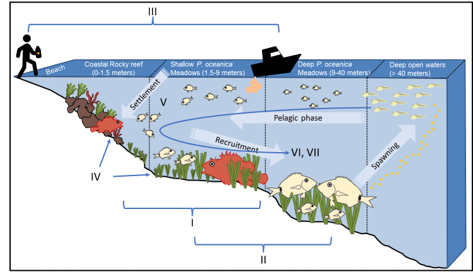PhD defense!
27/09/2017 11:00Carlos Díaz Gil became a new PhD yesterday after succesfully defended his thesis entitled: Settlement and Recruitment Processes in Fish Species of Interes for Recreational Fisheries; at the Univerity of the Balearic Islands within the Fishecology Group from IMEDEA.
Here a graphic and written summary of this PhD thesis:

The processes that regulate the settlement phase in marine fish species, passing from pelagic larvae to juveniles associated with the benthos, are complex and play a key role in the population dynamics. Examples of these processes are the duration of the pelagic larvae stage, metamorphosis, the orientation towards their adult habitat, adaptation to different predatory field or changes in feeding. While these processes are widely studied in coral reef fishes, knowledge of these early life stages is still scarce for temperate regions.
In the Mediterranean Sea, these fish species are subjected to high anthropogenic pressure, either due to pollution, environmental physical alterations or direct exploitation by fishermen. More concretely in the Balearic Islands, Spain, the pressure of recreational fisheries is high enough to be considered as a not negligible stress factor on fish population dynamics and this recreational activity has been steadily increasing for the last years. Furthermore, the recreational fisheries are locally concentrated in areas around towns, normally close to small bays where other environmental stressors are particularly acute.
This thesis evaluates some of the effects of this anthropogenic interaction with the fraction of the fish community that is not directly affected by recreational fishing, i.e. recruits or juveniles, through a series of field collected datasets, laboratory experiments and the use of other indirect indicators of fish fitness such as otoliths.
In the field based chapters, we first describe the sequential use of Posidonia oceanica seagrass meadows as nursery habitats by a wide range of juvenile fish, and how this transient community has changed in the last half century. A key example is the increase in abundance of juvenile Diplodus annularis in shallow seagrass meadows. We then describe and apply a method based on stereoscopic video-filming to better understand the nursery function of P. oceanica meadows. This work generates new potential for further studies including the quantification of nursery function.
Regarding the experimental chapters, we looked at the potential anthropogenic effects on early juvenile dynamics. First, the increment of fatty acid composition of larval fish associated with ocean acidification derived from the humanly induced increment of CO2 in the atmosphere is suggested. At a more local scale, we show the effect of polluted waters (sunscreen and harbour-influenced water) on the behaviour of juvenile gilthead seabream (Sparus aurata). Additionally, we use this last model species for an experiment on the predator-induced phenotypic adaptations. We describe for the first time in a marine species that the odour of predation induced changes in shape, which are reversible.
In the last part of this thesis, we include two chapters evaluating the multiple uses of otoliths (including shape, growth, and microchemical analysis) as indirect indicators of fish life history traits (LHT) among a wide set of experiments and field collected data. Firstly, we proved that the use of otolith fluctuating asymmetry (OFA, as the difference between the pair of bony structures) was not correlated with fish fitness or survival success, contrarily to mainstream belief. Secondly, we found for the first time in the field, that differences in otolith microchemistry among subpopulations may be due to differences in their LHT, which in turn may be affected by recreational fishing pressure.
We believe that this thesis has achieved it mains objective: filling several knowledge gaps about settlement/recruitment processes of coastal fish species, many of them highly relevant for recreational fisheries in the Mediterranean Sea.
———
Back
